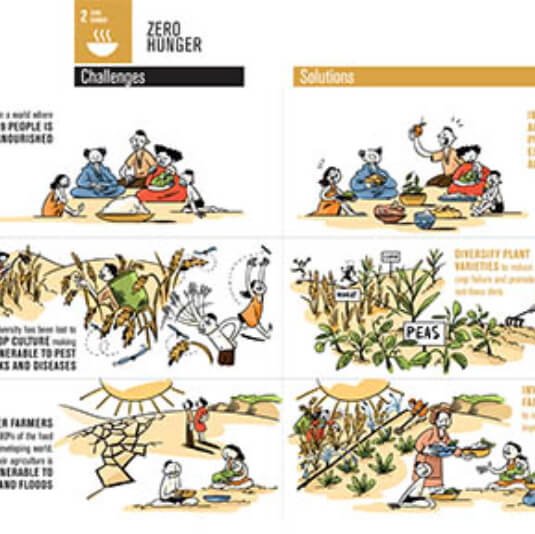The fundamental right to adequate, safe, and nutritious food should be unquestionable in the face of global challenges. However, hunger continues to be a widespread problem in various regions worldwide. The United Nations Sustainable Development Goal (SDG) 2, Zero Hunger aims to eradicate all forms of malnutrition, guarantee food security, and promote sustainable agriculture by 2030. This article explores the importance of SDG 2, the advancements achieved to date, the ongoing obstacles, and the strategies necessary to realize a hunger-free world.
Hunger and malnutrition are among the most urgent issues facing the world today. According to the Food and Agriculture Organization of the United Nations, the 2023 edition of the report reveals that between 691 and 783 million people faced hunger in 2022, with a mid-range of 735 million. This represents an increase of 122 million people compared to 2019, before the COVID-19 pandemic.
The impact of SDG 2 extends beyond the elimination of hunger. Zero hunger is the foundation of human progress. Hunger stifles personal development, reduces economic prospects, and perpetuates poverty, . It is also linked to a variety of global issues, including climate change and wars, making eradication critical for a more peaceful and sustainable world.
SDG 2 has a wide variety of particular aims. It strives to eliminate hunger and guarantee year-round access to safe, nutritious, and adequate food, emphasising vulnerable groups such as children, the elderly, and those living in conflict zones. Another important goal is to eradicate all kinds of malnutrition by lowering stunting and wasting in children under five and addressing the nutritional needs of teenage girls, pregnant and lactating mothers, and older persons. SDG 2 also aims to double agricultural production and earnings for small-scale food producers by improving their access to land, technology, markets, and sustainable farming techniques. It also emphasises the significance of sustainable food production systems and resilient agricultural techniques that increase productivity, preserve ecosystems, and improve resilience to climate change and other environmental issues. Finally, SDG 2 aims to preserve the genetic variety of seeds, cultivated plants, and domesticated animals, which is critical for food security and agricultural resilience.

Significant progress has been made towards SDG 2. Between 2000 and 2019, the proportion of undernourished persons worldwide fell from 15.7% to 9.4%. Many governments have established effective food security and nutrition programmes to protect vulnerable people. Agriculture innovations and the use of sustainable agricultural methods have increased food production and access.
SDG 2 is a complicated but vital target that necessitates collaborative efforts from governments, international organisations, the commercial sector, and civil society. We can eliminate global hunger by concentrating on sustainable agriculture, boosting food security, and providing sufficient nutrition. Addressing the underlying causes of hunger and malnutrition is critical to attaining SDG 2. It is more than just supplying food; it is about ensuring that everyone has the chance to live healthy and productive lives. With persistent work and innovation, we can achieve a world without hunger.
Child Help Foundation along with Filaantro has made infinite contributions to eradicating hunger in various parts of the country with the help of generous donors. To date, the organization has served 25,67,257 people through Roti Ghar and Free Food Distribution. The organization is extremely grateful to serve these many people and continues to do so with free food distribution service.
